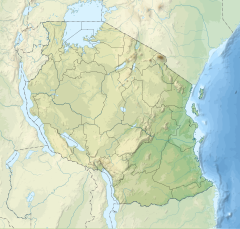Kilimanjaro National Park
| Kilimanjaro National Park | |
|---|---|
|
IUCN category II (national park)
|
|

Entrance to Kilimanjaro National Park
|
|
| Location | Kilimanjaro Region, Tanzania |
| Coordinates | 3°04′S 37°22′E / 3.067°S 37.367°ECoordinates: 3°04′S 37°22′E / 3.067°S 37.367°E |
| Area | 1,688 km2 (652 sq mi) |
| Established | 1973 |
| Visitors | c. 52,000 per year |
| Governing body | Tanzania National Parks Authority |
| Type | Natural |
| Criteria | vii |
| Designated | 1987 (11th session) |
| Reference no. | 403 |
| State Party | Tanzania |
| Region | Africa |
Kilimanjaro National Park is a Tanzanian national park, located 300 kilometres (190 mi) south of the equator and in Kilimanjaro Region, Tanzania. The park is located near the city of Moshi. The park includes the whole of Mount Kilimanjaro above the tree line and the surrounding montane forest belt above 1,820 metres (5,970 ft). It covers an area of 1,688 square kilometres (652 sq mi), 2°50'–3°10'S latitude, 37°10'–37°40'E longitude. The park is administered by the Tanzania National Parks Authority (TANAPA).
The park generated US $51 million in revenue in 2013, the second-most of any Tanzanian national park, and was one of only two Tanzanian national parks to generate a surplus during the 2012-13 budget year. (The Ngorongoro Conservation Area, which includes the heavily visited Ngorongoro Crater, is not a national park.) The fees for park usage and for climbing Mount Kilimanjaro during the 2015-16 budget year are published on the Internet. TNPA has reported that the park recorded 58,460 tourists during the 2012-13 budget year, of whom 54,584 were foreigners. Of the park's 57,456 tourists during the 2011-12 budget year, 16,425 hiked the mountain, which was well below the capacity of 28,470 as specified in the park's General Management Plan.
In the early twentieth century, Mount Kilimanjaro and the adjacent forests were declared a game reserve by the German colonial government. In 1921, it was designated a forest reserve. In 1973, the mountain above the tree line (about 2,700 metres (8,900 ft)) was reclassified as a national park. The park was declared a World Heritage Site by the United Nations Educational, Scientific and Cultural Organization in 1987. In 2005, the park was expanded to include the entire montane forest, which had been part of the Kilimanjaro Forest Reserve.
A variety of animals can be found in the park. Above the timberline, the Kilimanjaro tree hyrax, the grey duiker, and rodents are frequently encountered. The bushbuck and red duiker appear above the timerline in places.Cape buffaloes are found in the montane forest and occasionally in the moorland and grassland.Elephants can be found between the Namwai and Tarakia rivers and sometimes occur at higher elevations. In the montane forests, blue monkeys, western black and white colobuses, bushbabies, and leopards can be found.
...
Wikipedia

